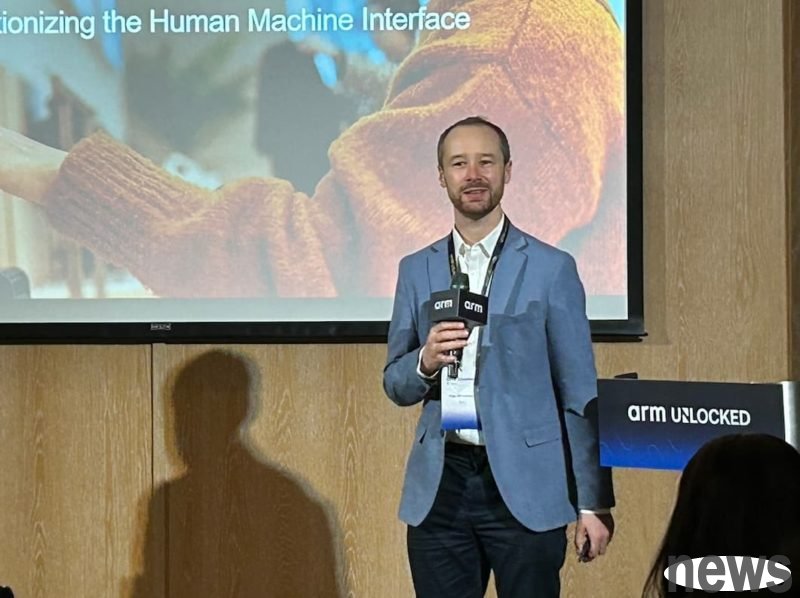
Arm, the leader in semiconductor silicon intellectual property (IP), held the Technology AI Leadership Summit "Arm Unlocked Taipei Forum" today (13th). Paul Williamson, Arm's senior vice president and general manager of the Internet of Things Division, pointed out that AI is a new development and a new user interface. It is rapidly changing the entire industry and redefining "computing."
Williamson believes that with the acceleration of technology adoption, the world is entering a new era of "Agent AI" (Agentic AI). AI no longer just provides search or assistance, but actively makes decisions and takes action. Combining sensors and actuators, these systems have the ability to impact the real world, driving a strong need for low latency and immediate response. These AI experiences force a rethinking of hardware design and require solutions to accelerate computing. In addition, physical limits have also become bottlenecks. Today's largest data centers are limited by energy consumption and power generation capabilities, and are unable to support rising computing demands. Therefore, Arm must promote high-performance, low-power computing innovation.
Williamson said that AI is also revolutionizing the way humans interact with computers. The next generation of users will use "voice" as the main interface, interacting directly with devices using natural language instead of through cumbersome application operations. In other words, humans will move from "touch interface" to "natural voice interface", which also means that wisdom will have a broader "global context", be able to understand the environment and situation, and operate safely. This kind of real-time, intuitive, natural language-based interaction will become mainstream.
At the same time, trust is also very important. Williamson believes that these devices, cameras and sensors must be trusted to operate safely to ensure that personal data is protected. AI must be able to understand users while ensuring privacy and security, so that users can rely on these smart devices with confidence. Natural language interfaces have already begun to appear in cars, but in the future it will be widely used in more fields, such as robotics. Even in traditional industries, such as retail and point-of-sale (POS) systems, human-computer interfaces will be transformed again, from simple touch operations to smart interfaces that can understand user intentions and provide personalized interactions.
Why is AI heading to the edge? Arm looks at "five key factors" driving a new era of computingWilliamson then quoted data from research institutions, saying that by 2030, the market size of high-performance system-on-chip (SoC) driven by AI will exceed US$100 billion; by 2028, AI will become the most commonly used core technology in Internet of Things (IoT) projects; investment in edge AI infrastructure will also increase by 60% by 2028.
This also means that more and more people will deploy AI devices and hardware at the edge. So what exactly is driving AI to the edge? Williamson said that there are many key factors that jointly promote the transformation. First of all, the first key factor that promotes the development of AI to the edge is "latency." In scenarios that require real-time decision-making, if data must be sent to and from the cloud for processing, the response will be slow, so decision-making must be completed on the local device. Secondly, there is "privacy and trust." When smart devices enter the home or workplace, only by ensuring that data can be encrypted, processed, and stored locally can personal information security and user trust be established.
The third is "energy efficiency". Although the cloud data center has powerful computing power, the energy consumption of transmitting large amounts of image and voice data is extremely high, so the data needs to be processed at the edge to improve energy efficiency and response speed. The fourth is "economic model". Large model developers and companies are unwilling to bear the huge inference costs alone, and hope to disperse the computing to user devices to make it more cost-effective and form a new economic ecology. The last is "resilience". In this seemingly ubiquitous world, it is often taken for granted that the network will always be stable, but if we want to AI is deployed around the world, and not every region has a complete connection environment or government infrastructure. Therefore, the system must have "local computing capabilities" and be able to operate on its own in the deployment environment.
Edge AI moves to a new architecture with low power consumption and always-on operationWilliamson also believes that with the popularity of AI applications, not all artificial intelligence relies on cloud computing. Many devices are actually "always-on AI computing" AI computing systems. For example, from smart cameras with forward monitoring functions to smartphones that can actively understand user behavior, AI is evolving from simple event detection to systems with situational understanding capabilities.
Such an evolution has shifted the focus of system design to a "low power consumption, constant operation" computing model. This type of device needs to process various sensing data, such as images (identifying people's identities), movements (understanding behavior and location), and even other environmental signals, and wake up high-power modules when interactions occur to complete real-time inferences and decisions with stronger computing power. This "context-level" AI architecture can strike a balance between energy saving and performance to support the long-term operation requirements of future devices.
He also believes that the design of future devices must be clearly partitioned. For example, the always-on subsystem is responsible for low-power monitoring and sensing, while the high-power block focuses on complex model inference. The switching between the two must be seamless so that the user experience is natural and smooth. This layered architecture will become the mainstream direction of edge AI devices and will also bring higher efficiency and smarter experience to smart terminals..
Further reading: Siemens debuts Signaling Hope the wafer foundry department turns losses into profits! Samsung aims to achieve 20% market share by 2027